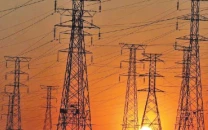Electricity crisis: govt caught between devil and deep blue sea
Up to 16 hours of load-shedding is being carried out in different parts of the country

The country has plunged into a crippling electricity crisis that is mostly attributed to mismanagement, inefficiencies, power theft and politically-motivated appointments in the power utilities.
The ongoing power crisis has affected businesses and piled miseries on the masses, who suffer load-shedding in the merciless summer heat. Observers believe that the prolonged power outages could have political repercussions for the incumbent government.
According to Economic Survey recently released by coalition government last month, the installed capacity of electricity in Pakistan had reached 41,000 megawatts (MW), which was the highest in the country’s history, but, at the same the demand has also gone up.
When the coalition government came into power in April, the first issue, it faced was a 7,000MW shortfall, because of the closure of several power plants on account of maintenance, technical faults and unavailability of the fuel.
Read more: Heads to roll if power crisis not rein in: PM
The government has the control over the import of liquefied natural gas (LNG), which is used by several power plants to generate electricity. The Pakistan LNG Limited (PLL) had been unable to secure LNG due to high prices, leading to its shortage in the country.
Recently, the PLL did not accept bids for LNG cargoes due its exorbitant price, which was at high as $39.8 per million british thermal unit (mmbtu). Now, only 8 LNG cargoes of about 800 million cubic feet (mmcfd) would be available in July under long-term contract with Qatar.
This is important issue that government has no gas available for power plants. The alternate fuel is the furnace oil but its prices had also gone up to Rs 188,908 per metric ton – almost double of the rate six months ago.
Even if government uses expensive LNG and the furnace oil in power plants, the electricity bills of the consumers will go up to a record level, compromising the capacity of the consumers to pay the bills – hence another political backlash for the government.
Secondly, Pakistan did not have enough cash to pay dollar against import of LNG and furnace oil to meet the demands of power plants. Cash issues is also making the government’s ability to arrange expensive gas and oil.
Also read: Electricity shortfall hits 6,000MW
Because of the lack of cash, coal power plants had also suffered. The present government had announced to release Rs100 billion to coal-based plants. Despite making allocation of some portion of money, there has not been any improvement in the load-shedding situation.
Circular debt
When the previous Pakistan Tehreek-e-Insaf (PTI) government came into power, the circular debt stood at Rs1.6 trillion. During the 44-month tenure of the Imran Khan-led government, the circular debt continued to rise and had now reached Rs2.7 trillion.
In the meantime, defaulters in the power sector had also increased the difficulties of the power utilities. The dues against defaulters stood at Rs1.6 trillion in December 2021. The running defaulters also include those still receiving electricity despite failing to pay the bills in time.
These dues had jumped to Rs 1.7 trillion, as of now, due to a constant failure of the Energy Ministry and the power companies to improve the recovery system, coupled with the inaction of the authorities concerned against the defaulters.
The poor recovery of the bills during the last few years is another reason to affect the entire energy chain. At present, the dues recovery has been hovering between 86 and 89 – a low rate mainly because of inefficiencies of power companies and power theft.
Politically motivated appointments of heads and board of directors in the power companies during the previous PTI regime was another reason that led to failure of the energy sector to perform.
The power outages may continue due to these reasons in coming months. At present, the power shortfall has stayed more than 7,000MW. According to Power Division sources, the total power generation is 21,406MW against a demand of 28,638MW.
Prime Minister Shahbaz Sharif had recently announced import of coal from Afghanistan. But it would require huge funding – a weekly allocation of almost $25 million. In addition the government requires $51.5 million for debt servicing of imported coal power plants.
In the meanwhile, up to 16 hours of load-shedding is being carried out in different parts of the country. The duration of load shedding is even longer in areas where the losses were very high, Power Division sources added.
At present, the total electricity generation of private sector power plants is 11,147MW, while 5,462MW is being generated from water and 1,602MW by the government’s thermal plants, the sources said. Wind power plants are generating 677MW, solar plants 116MW, bagasse-based plants 121MW and nuclear fuels 2,281MW of electricity.



















COMMENTS
Comments are moderated and generally will be posted if they are on-topic and not abusive.
For more information, please see our Comments FAQ